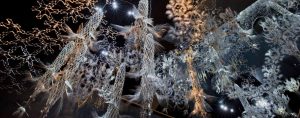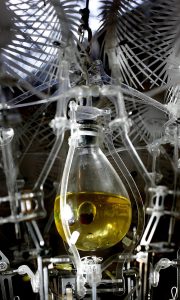
This art piece is called the Hylozoic Veil, a living construction of sensors, chemical beakers, and delicate acrylic links and fronds. Created by Philip Beesley, Hayley Isaacs, and Benjamin Wiemeyer, and displayed around the globe, it is a marriage of science, computer programming, and art. It is currently displayed at three stories high in The Leonardo, a museum located in Salt Lake city, Utah. When guests enter the museum, the Hylozoic Veil senses human presences and reacts, unfurling plantlike fronds, or stretching and compressing subtly. It even has sections attached to beakers, which filter and collect chemicals like Carbon Dioxide, much like the processes of several living organisms. The project itself was, according to Beeler, modeled off of protocells: “prototype cells that use inorganic ingredients combined into cell-like forms.” Its construction took the work of several volunteers, as well as the writing of entirely new programs in order to manage the complex chemical processes that make the project tick, including the millions of microsensors. The project itself is not meant to be seen merely as a sculpture, but as an environment. It breathes as guests engage with it, and lives on when the museum closes for the day.

This piece inspires me because it embodies the marriage of art and science that I aspire to in my career, as well as the ingenuity and delicacy that went into it’s construction. It kindles thoughts of a future where, should the forests on the earth ever disappear, something as eerily beautiful as this may replace it. It is exciting to think about what future projects this may inspire, and what other artistic “environments” may arise.
Philip Beesley’s Website and his own post about the Veil
![[OLD FALL 2017] 15-104 • Introduction to Computing for Creative Practice](wp-content/uploads/2020/08/stop-banner.png)